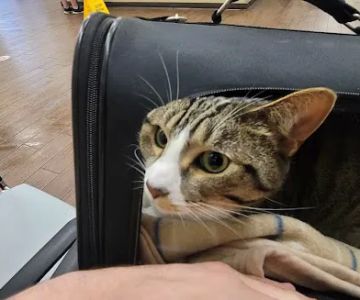How to Groom a Long-Haired Cat at Home: Tips and Techniques
If you have a long-haired cat, you know that grooming can be a time-consuming yet essential part of their care routine. As someone who has had several long-haired cats over the years, I can tell you that regular grooming not only keeps their coat looking beautiful but also helps maintain their overall health. The good news is, with the right tools and techniques, you can easily groom your long-haired cat at home, saving both time and money. Let me walk you through the process, share some personal stories, and provide tips for a stress-free grooming session for both you and your feline friend.
1. Understanding the Importance of Grooming
Grooming a long-haired cat isn’t just about aesthetics—it’s a key part of maintaining their health and comfort. Long-haired cats are more prone to matting, tangling, and even skin conditions due to their thick, dense fur. Regular grooming helps prevent these issues by keeping the coat free from knots and tangles, which can lead to painful mats or skin irritation. It also reduces shedding, prevents hairballs, and helps distribute natural oils across the coat, keeping it shiny and soft.
I remember the first time I tried grooming my long-haired cat, Fluffy. I was overwhelmed by the sheer amount of fur she shed just from brushing! But once I got the hang of it, I realized that grooming was a rewarding experience for both of us. She seemed to relax during our sessions, and her coat looked and felt amazing afterward.
2. Gathering the Right Tools for Grooming
Before you start grooming your long-haired cat, it’s important to have the right tools. While you can use basic brushes, having the right type of grooming equipment can make all the difference in the world. I recommend having the following tools on hand:
- Wide-Tooth Comb: Perfect for detangling mats and working through the undercoat without pulling on the cat’s fur.
- Pin Brush: Ideal for removing loose hair and preventing tangles from forming.
- De-matting Comb: Useful for gently loosening and removing any stubborn mats that may have formed.
- Shedding Blade or Undercoat Rake: Designed for thick or dense coats, these tools help remove dead hair and prevent shedding.
- Nail Clippers: While not directly related to coat grooming, keeping your cat’s nails trimmed is essential for their health and comfort.
The first time I tried using a shedding blade on my cat’s coat, I was amazed at how much loose hair came off. I quickly realized how important it is to use the right tools to make the grooming process as efficient and comfortable as possible for your cat.
3. Brushing Your Long-Haired Cat: The Right Technique
When it comes to brushing a long-haired cat, patience is key. Start by brushing your cat gently and slowly, working in small sections. I like to start with a wide-tooth comb to work through any tangles or mats in the undercoat, and then follow up with a pin brush to remove loose fur. Always brush in the direction of the fur growth to avoid causing discomfort. It’s important to be gentle, as tugging on mats can hurt your cat.
During grooming sessions, I found that taking breaks helped prevent both my cat and me from getting frustrated. Cats often get anxious when held in one spot for too long, so I would give Fluffy a short break every 10 minutes. It was a great way to keep the session calm and stress-free. Regularly grooming your cat, even just for a few minutes each time, can keep their coat looking great without overwhelming either of you.
4. How to Handle Mats and Tangles
One of the biggest challenges when grooming a long-haired cat is dealing with mats and tangles. These can form in areas where the fur rubs against the skin, such as under the arms, behind the ears, or around the neck. If left untreated, mats can become very tight and cause discomfort or even skin irritation. I’ve personally had to deal with a few mats over the years, and I’ve learned that the best approach is to gently work through them with a de-matting comb or wide-tooth comb.
If the mat is too tight to remove safely with a comb, you can try gently cutting it out with scissors, but be extremely careful not to cut your cat’s skin. I learned this the hard way when I accidentally nicked Fluffy’s skin once, which made her fearful of future grooming sessions. To prevent this, I now take extra care when tackling mats and always use specialized de-matting tools that allow me to remove tangles more gently.
5. Bathing Your Long-Haired Cat
Bathing your long-haired cat isn’t something that needs to be done frequently, but there are times when it’s necessary—especially if your cat has gotten into something sticky or dirty. Bathing can also help with shedding and maintaining a shiny coat. I always make sure to use cat-specific shampoos that are gentle on their skin and fur. Long-haired cats are more sensitive to harsh chemicals, so using the right products is crucial.
When giving my cats a bath, I use lukewarm water and make sure to keep the process as calm and stress-free as possible. It’s important to be gentle when wetting and rinsing their fur, as long-haired cats can get cold more easily. After the bath, I towel-dry my cat thoroughly and then comb through their wet fur. Drying a long-haired cat properly helps prevent mats from forming and ensures that their coat remains soft and tangle-free.
6. Keeping Your Cat’s Nails Trimmed
While trimming your cat’s nails doesn’t directly affect their coat, it’s an essential part of grooming. Long-haired cats can sometimes have difficulty scratching or even walking if their nails are too long. I recommend using a pair of cat nail clippers and trimming the nails carefully to avoid cutting into the sensitive quick inside the nail.
During grooming sessions, I always take the time to trim my cats' nails. This prevents them from becoming too long and uncomfortable. I also make sure to praise and reward my cats after each grooming session to associate the process with positive reinforcement, which helps make future grooming sessions easier.
7. Grooming Tips for a Stress-Free Experience
Grooming your long-haired cat at home can be a rewarding experience for both you and your feline friend if you follow a few simple tips:
- Be patient: Cats can be sensitive to touch, so take your time and give them breaks if needed.
- Start young: If you begin grooming your cat as a kitten, they will be more likely to tolerate and even enjoy grooming sessions as adults.
- Use treats: Reward your cat with a treat after each grooming session to create a positive association with the experience.
- Set a routine: Regular grooming helps your cat get used to the process and reduces stress over time.
By following these tips, you’ll be able to keep your long-haired cat looking great and feeling comfortable. And the best part? You’ll bond with your cat through the process, which makes it even more enjoyable for both of you!











